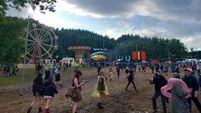Cork In 50 Artworks, No 35: Turlough Cowman’s Millennium Sundial, at Dursey Sound

Turlough Cownan and Pat O’Neill aligning the Millennium Sundial at Dursey Sound in West Cork in 1999. Picture: Niall Duffy
At 4.16pm on December 31, 1999, President Mary McAleese lit a candle at Aras an Uachtaráin to coincide with the last sunset of the 20th century. The Taoiseach, Bertie Ahern, then lit a number of candles in Merrion Square in Dublin, representing the gardaí, nurses and the fire services. And so it went; over the next twenty-five minutes, as the light drained from the sky, candles were lit all across the country to mark the end of the millennium.
The very last Millennium Candle was lit at 4.41pm by the late Minister for Agriculture, Joe Walsh, at the Dursey Sound, at the tip of the Beara peninsula in West Cork. Piper Brendan Ring performed a series of slow airs, and the large crowd present clapped and cheered, as the sun disappeared in a riot of colour into the sea off Dursey Head. The Castletownbere lifeboat, idling in the Sound, fired off flares, and two huge bonfires were lit on Dursey Island.
Shortly before, the same crowd had witnessed the unveiling, at the roadside nearby, of a Millennium Sundial, commissioned by the National Millennium Committee and created by Youghal, Co Cork artist Turlough Cowman.
“I can’t quite remember who approached me to make the sundial,” says Cowman. “But I know it was a direct commission, and I didn’t submit a proposal for a competition or anything.” He was an obvious choice for the project; a graduate of the Crawford College of Art & Design in Cork, he’d had help from East Cork Area Development in setting up in business as Precision Sundials, and had already completed a number of similar projects around the country.
He remembers driving down to inspect the site. “I brought a theodolite, and surveyed it properly to establish, firstly, if the project was feasible, and secondly, whether I could accurately pinpoint due south. Thankfully, I could. One of the features of the sundial is a map of the Beara peninsula, with a line through it that points exactly to where the sun would set on the Millennium.”
The sundial was to be made of Kilkenny limestone, but Cowman had never actually carved one in stone before. “So I got help from a neighbour, a local stonemason named Adrian Budds. Another neighbour, Jim Browne, gave me the use of a yard to work in. I spent between four and six weeks making the sundial, and I drove back down to Dursey Sound with it myself, in the bed of a trailer, the weekend before Christmas. The face of the sundial is 90cm wide, but it’s only about 2.5mm thick. So it didn’t weigh much, about 100kg, but still, that was a long drive down from Youghal in the dead of night in December.”
Two local men, Pat O’Neill and Pat O’Sullivan, had already constructed a plinth and landscaped the area around it, and they were on hand to help him set the sundial in place.
“It was a bitterly cold day, but the lads were great. They taught me the simple pleasures of sticking a shovel into cement and mixing it.”
The Last Light ceremony at Dursey Sound on 31st December was billed as the last sunset of the millennium in western Europe, and inevitably, it became the focus of much media attention. In the years leading up to the end of the 20th century, there had been much talk of a “millennium bug”, a glitch that threatened to take down computer systems worldwide.
Interviewed by the Irish Examiner around the time he installed the sundial, Cowman reasoned: “There’s no reason why it shouldn’t last a thousand years; it’s Y2K compatible.”
He travelled back down for the unveiling, at which Fr Liam Comer PP, Allihies, and Maud Levis, of St Peter’s Church of Ireland, Castletownbere, recited prayers, and the Allihies Choir sang hymns in Irish and English. He remembers one particular highlight of the occasion: “I was interviewed live by Charlie Bird for RTÉ.”
Cowman continued making sundials for some years, completing public commissions in Dungarvan and Stradbally, Co Waterford, but he never particularly enjoyed managing the business side of things.
“Eventually, I drifted naturally into working with computers. I retrained as a programmer, and that’s what I work at today. In an odd way, programming gives me the same satisfaction as making art, in that I can always bring things to a fluid, logical, clean, deep conclusion. There’s the same sense of capturing the motion of the sun around the earth, and knowing where we are, exactly, at this point in time.”






